We all know what grass is, even if we don’t pay it much attention. We use it as a pitch for our childhood games and picnics, as a seat to relax on whilst listening to mediocre musicians at festivals, or as a bed to lie on for a sunny afternoon doze.
But we don’t value grass as much as we value trees. Even the campaign No Mow May seems to focus on the flowers you will find in your lawn if you don’t mow it, not the grasses themselves.
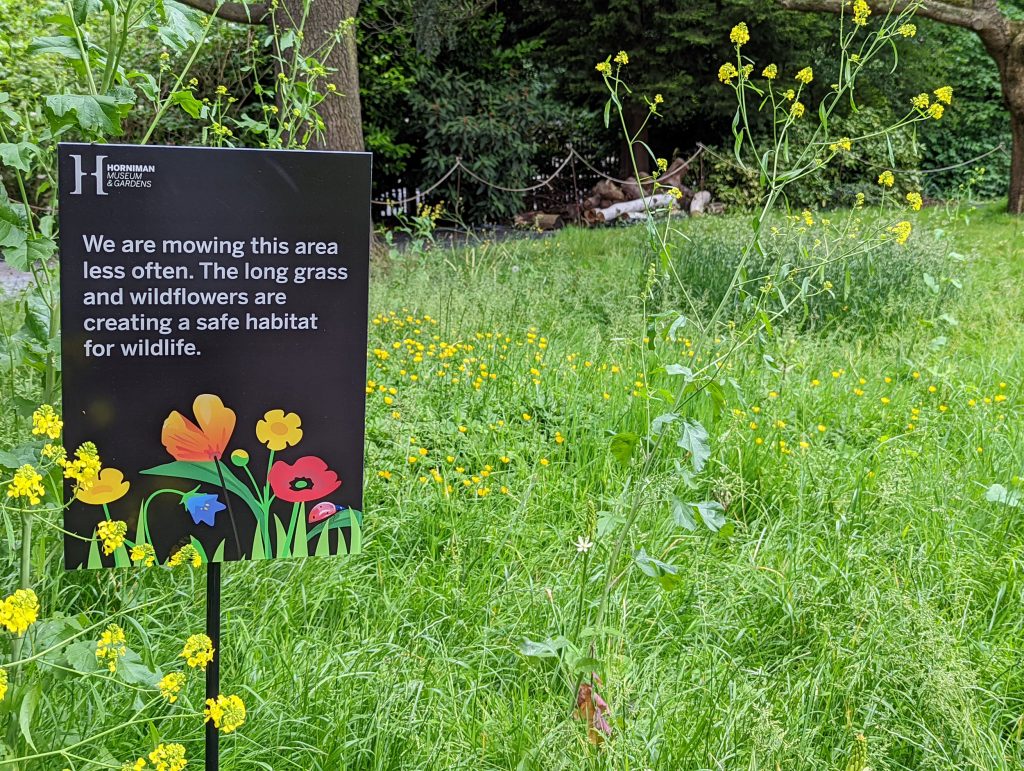
Leaving areas unmowed is great for grass, which is great for the planet.
Perhaps it’s time to give grass the attention it deserves.
The good news is you don’t have to travel far to find grass. The Nature Trail has a small and rather trampled meadow area, but there are even more impressive swathes of beautiful grasses in the Horniman Gardens, looking relaxed and much better now they are being allowed to grow to their full extent and come to flower.
Good for the planet
There is much written on the importance of good quality grassland habitats in tackling climate change.
Good grassland harbours thousands of species of grass, flowers, fungi, and insects. Worms drag nutrients underground. The fungal networks work in harmony with the grasses, to use these nutrients to make numerous complex chemicals, such as the glomalins (which act as a kind of lubricant as the fungal hyphae push through the soil).
The carbon trapped in these chemicals stays in the soil, doing no harm. It is only released into the air as carbon dioxide if grassland biodiversity is destroyed by digging it up to plant trees (which happens all too frequently), overgrazing it, trampling on it, or by spraying chemicals on it.
Grasslands could be the thing which saves us if we look after it.
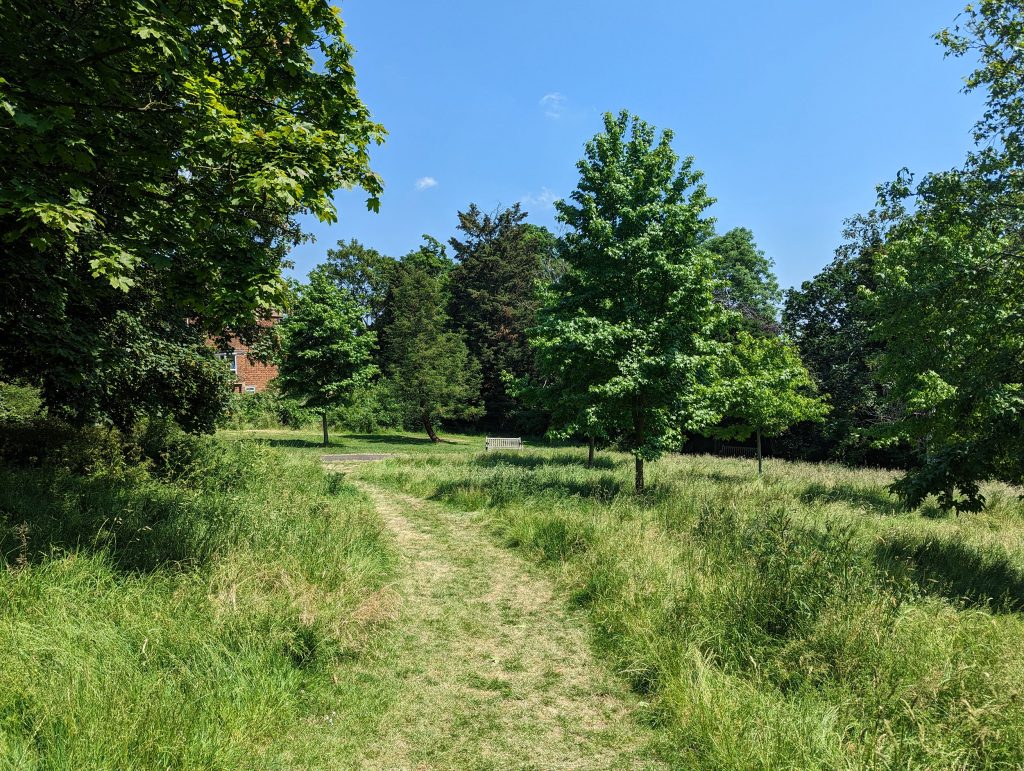
Patches of longer grass at the Horniman
If you want to know more, the United Nations website has information on soil and carbon capture and Isabella Tree’s bestseller Wilding has some very good and simply written sections on this topic, and on glomalins in particular.
Missing in action: grasslands
Grassland and meadows were (and are) often thought of as ‘man-made’ and therefore in some way inferior to woodland.
One of the reasons for this negative view of grassland in the UK is that we have destroyed nearly all our wildflower meadows since 1945, in part as an understandable attempt to increase food production after WWII. Many of us simply don’t remember what wildflower meadows are.
We are lucky in South London to have easy access to some of the best meadows in the country. If any of you have been to the magical London Wildlife Trust reserves at Chapel Bank and Hutchinson’s Bank in Croydon (a few minute’s stroll from the New Addington tram stop) – or the Corporation of London managed Farthing Downs (round the corner from Coulsdon station), you will see what an enormous array of species a sensitively managed grassland habitat can support.
The issue about the UK needing to produce more food and not having enough space for wildflower meadows is a little simplistic, now we know that 30-40% of our food produced is wasted.
If we are really concerned about food production and climate change, perhaps we could stop throwing good food away, and allow some of our beautiful meadows to flourish again.
Meadows are not just pretty, they may be as – if not more – powerful than woodland at capturing carbon. Unlike woodland, they can become effective at doing so in a couple of years, rather than the decades it takes before trees become productive at carbon storage. And they produce food and habitats for important animals, like rodents, butterflies, grasshoppers, bees, and craneflies.
How do you identify grass?
This year I tried, not for the first time, to get to grips with identifying grasses. As readers of my previous posts will know, I am not a great fan of peering through hand lenses. I like plants and animals you can identify by just having a look at them.
Like this Rose Chafer (Cetonia aurata) I found on an ox-eye daisy in my garden this morning.
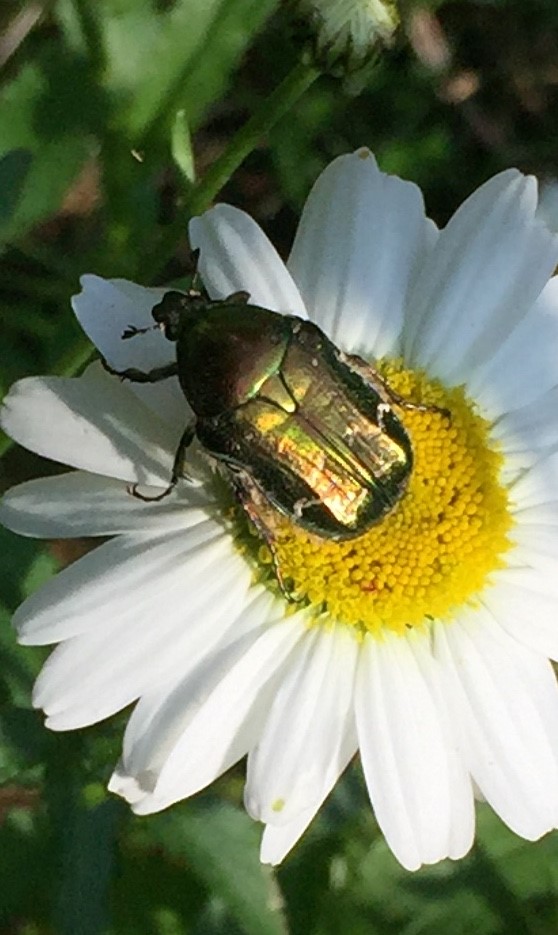
The beautiful rose chafer
As soon as I saw the Chafer I ran inside to get my phone and took a picture. I flicked through my insect book, and there she was. Rose Chafer. Nearly an inch long, a deep iridescent coppery green, and quite unmistakable. I’ve never seen one on the Nature Trail, but if you keep a look out on the dog roses along the trail this summer, you may be lucky.
The Rose Chafer, unlike most insects I find, was easy to identify. Most things are not, and grass certainly isn’t.
If I take a photo of a grass and try to identify it from a book, I will be none the wiser. A lot of them look rather similar, and by ‘rather similar’ I mean ‘exactly the same’.
One of the problems with grasses is that the books, ID guides and online resources are vastly inferior to those for flowers or birds. Grasses are poorly illustrated and hard to photograph properly.
Also, like fungi, they change dramatically as they go through their life-cycle. But as always, if we go slowly and learn a few at a time, we can make some progress. Once you know three or four common ones you can start on the others.
Three grasses to look out for this summer
Wall barley (Hordeum murinum)
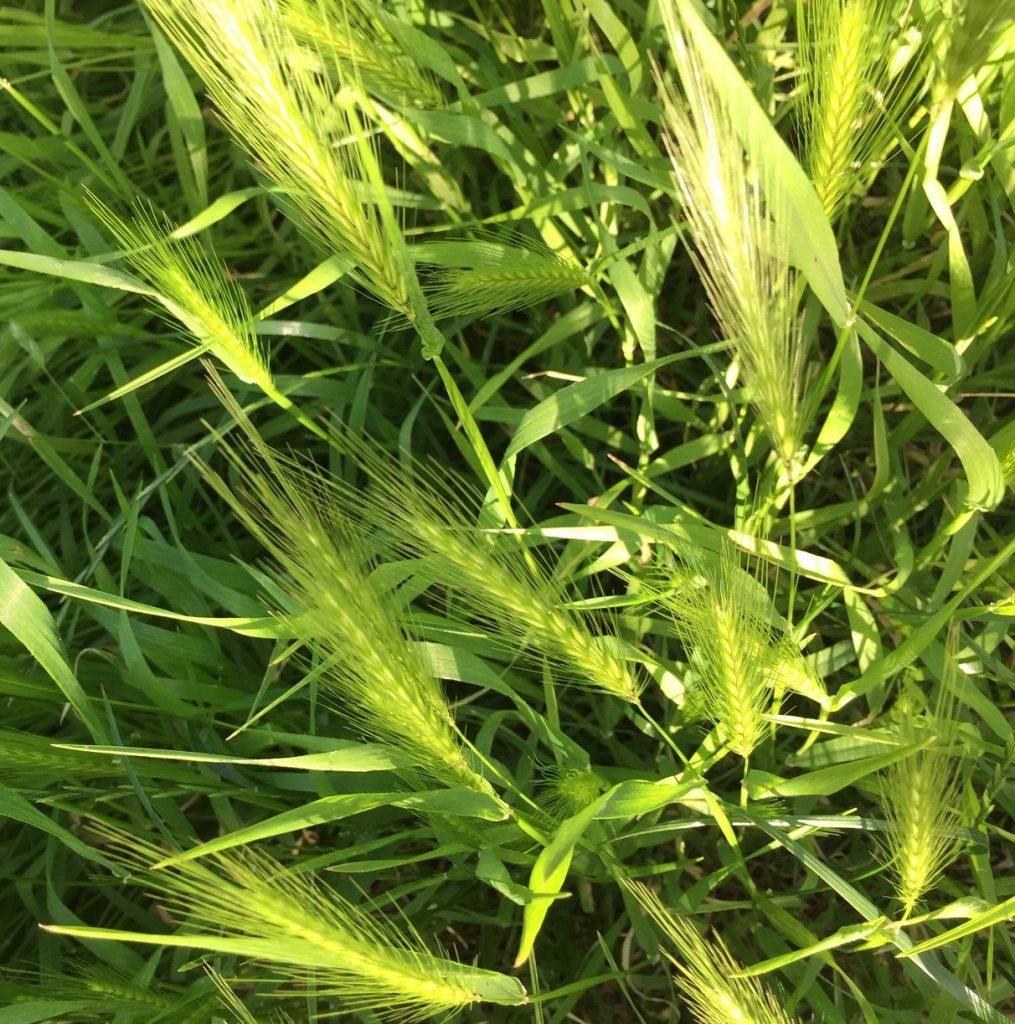
Wall barley
You might know this one already. There is not much of it on the trail but the Horniman Trail (not a part of the Gardens) just across the road from the Nature Trail is full of it.
You may know Wall Barley as arrow grass. Children used to throw the seed head ‘darts’ at each other when I was younger. When I was ten and my brother seven, we had a barley dart fight with my dad. A few days later he developed a horrible pain in his ear. There was nothing to see from the outside, but the pain was severe and his ear felt full. Thinking it might be an ear infection, he went to A and E at Bristol Royal Infirmary and was seen by the ENT specialist, who with some thin, long forceps, and a great deal of care, managed to extract, you’ve guessed it, a dart from the seed head of Wall Barley, which had worked its way deep into the ear.
Grass flowers are made of repeated units called spikelets, which are identical or near identical tufts along the top section of the stem of the grass. Spikelets may or may not have one or more awns. Awns are a stiff bristle which grows out from the spikelets.
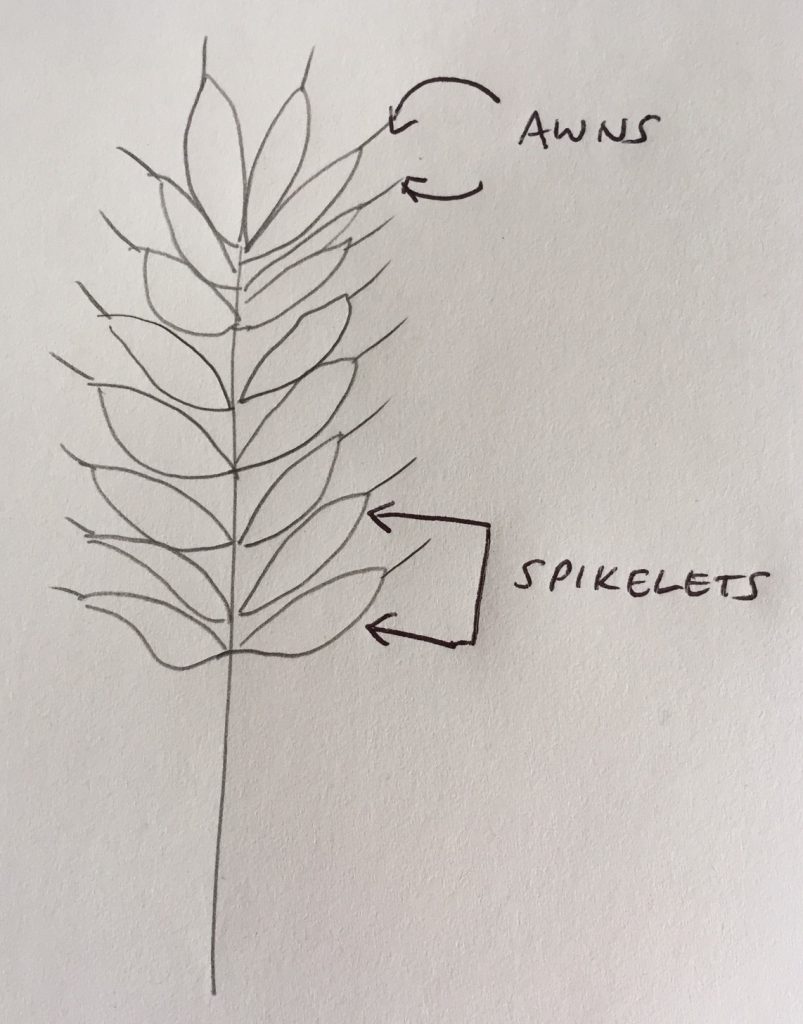
To help identify grasses, it is useful to know what the spikelets and the awns are
It is the awns, those stiff bristles, which make the dart fly through the air so smoothly and which make it so hard to extract from an ear canal. So if you have barley-dart fights (as indeed you should) please avoid aiming for the ears!
Cock’s foot (Dactylis glomerata)
This is another grass you will have seen as it is everywhere. Like many names in natural history, the name cock’s foot doesn’t make any sense.
According to the Wildlife Trusts’ website, “its rounded flower heads appear on long stalks and give the impression of a bird’s foot, hence the common name”.
Nonsense! The flower heads look nothing like bird’s feet, but because it’s such a stupid name it makes me remember it. Cock’s foot is abundant, tall, grows in tussocks and often looks more robust than the surrounding grass. Its most distinctive feature is that the leaves are blue-greyish green rather than full-on green. The leaf blades have sharp edges, as gardeners who weed by hand will know. Coarse, bluey grey, and with purplish seed heads which may or may not look like a cock’s foot. That’s cock’s foot.
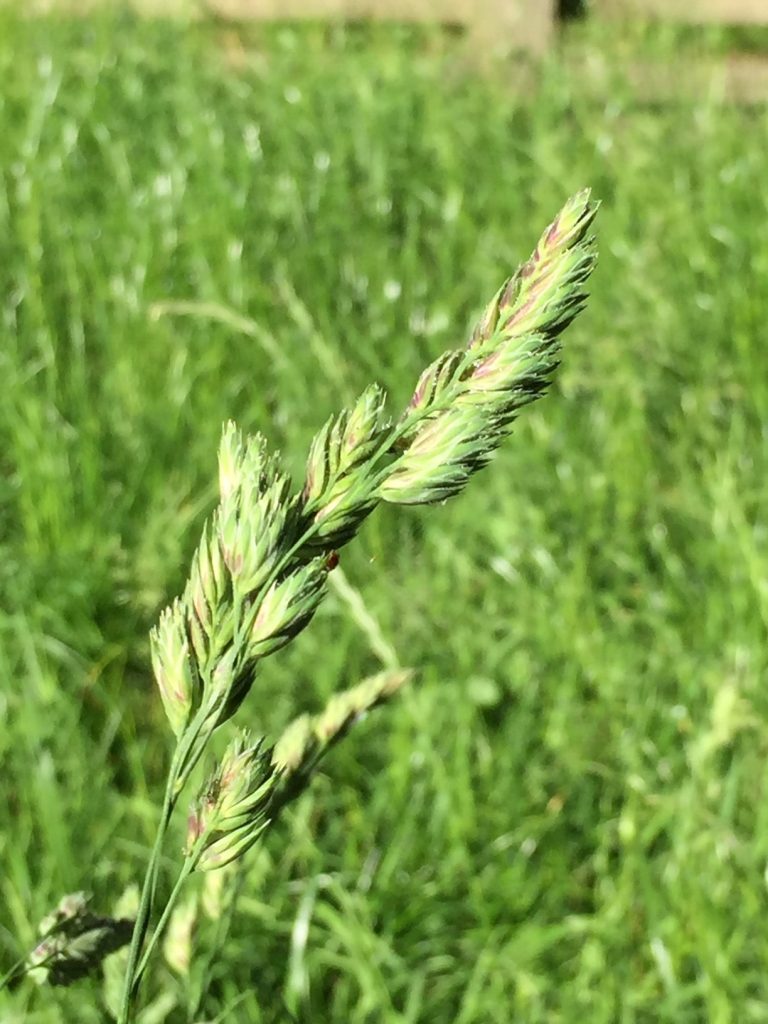
Cock’s foot grass
Perennial ryegrass (Lolium perenne)
This may be the most common grass in Britain. It’s abundant in the Horniman Gardens.
If you have a lawn or communal grassy area it is likely that this species will form the bulk of it, as perennial rye-grass is tough and resilient and a staple component of lawn seed mixes. You will find it in the grass of parks, playing fields and lawns.
It has a very characteristic flower head; slender with neat spikelets which do not have prominent awns sticking out. The spikelets are spaced quite evenly along the stem, and are all in one plane, so it is quite easy to lie the flower down flat. Here’s a bit I found in the Horniman Gardens.
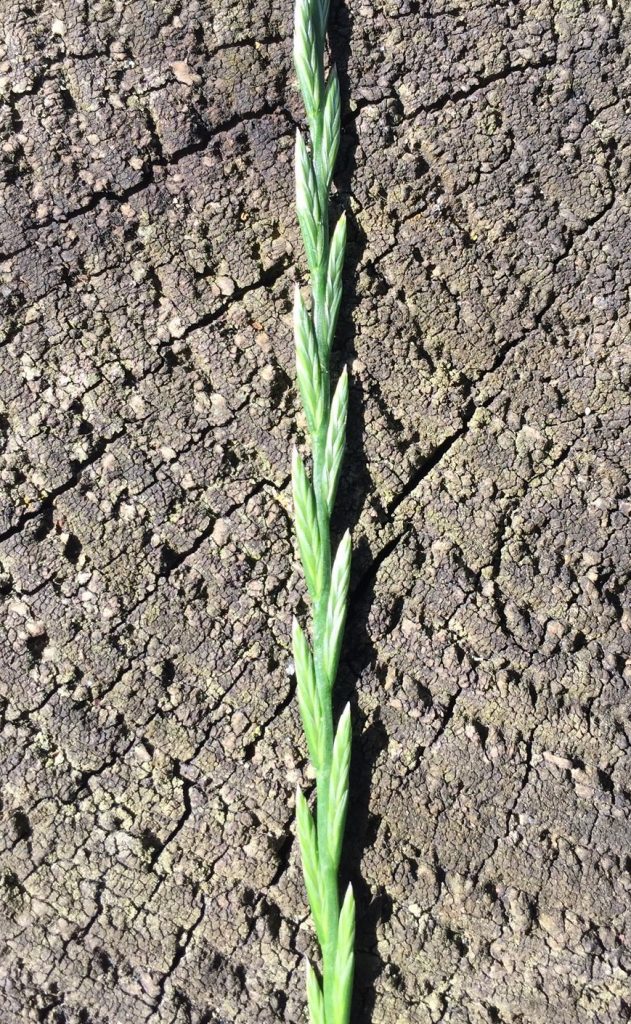
Perennial rye grass stalk
Want to know more?
If you want to reinforce this grass knowledge and learn a couple more species, I came across this video by Dr Phil Buckley from Canterbury Christ Church University. He takes you through the identification of five of the most common British grasses, all of which he finds and shows you in his back garden. I find his hints for remembering the Latin names of grasses completely absurd, but surprisingly effective.
There’s also a Field Studies Council laminated guide to common grasses which is nice to take with you on your strolls through summer parks and meadows.
The PlantNet app, which I have mentioned before, seems to work quite well for grasses if you can get a reasonably focused photo of the flower.


